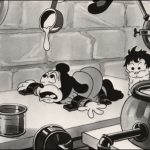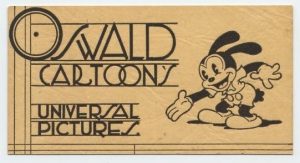


 By 1934, Universal pictures had become known for the horror film, which was and would remain a specialty for the studio. Apart from the cartoons, one hears very little about the studio’s short subjects production, although they had a successful newsreel, and were leaders in the production of serials. They were releasing the shorts of Warren Doane, but their lack of notoriety leads one to believe they were not particularly successful. In the field of animation, they seem to have satisfied exhibitors, as there is no widespread criticism of the quality such as with other studios like Terrytoons – yet also no shouts of high praise. Although Pooch the Pup never did catch on, the Oswalds were continuing, most recently with a run of operetta cartoons and gagged-up fairytales.
By 1934, Universal pictures had become known for the horror film, which was and would remain a specialty for the studio. Apart from the cartoons, one hears very little about the studio’s short subjects production, although they had a successful newsreel, and were leaders in the production of serials. They were releasing the shorts of Warren Doane, but their lack of notoriety leads one to believe they were not particularly successful. In the field of animation, they seem to have satisfied exhibitors, as there is no widespread criticism of the quality such as with other studios like Terrytoons – yet also no shouts of high praise. Although Pooch the Pup never did catch on, the Oswalds were continuing, most recently with a run of operetta cartoons and gagged-up fairytales.
Wolf! Wolf! (4/2/34) – This cartoon is based on the well-known fairy tale, “The Boy Who Cried Wolf.” A couple of mischievous lambs are having a delightful time making the false call to get Oswald to rush to them. As usual, a real wolf shows up, interests strictly culinary. The wolf is ultimately defeated, with no particular surprise ending. Song: “I Was Only Fooling, Fooling You”, sung by the lambs, an original.
Goldilocks and the Three Bears (5/14/34) – This also follows the basic plot of the fairy tale, except when the bears come back to their abode, they find Goldilocks has turned the place into a disaster area. Oswald serves as narrator, after a couple of false starts. Song: “We’re Jolly Bears”, another original as the bears go out to let their porridge cool.
The Gingerbread Boy (4/16/34) – Your basic nursery story cartoon, with a radio desperately trying to narrate the tale of a childless woman who bakes a “boy”: to a nice golden brown. Oswald is a listener trying to quiet a child. Songs: “I’m a Little Gingerbread Boy” (an original), and “Butterflies in the Rain”, a 1933 British novelty, recorded in England by Ray Noble and his New Mayfair Dance Orchestra for HMV, released here on Victor, with vocal by Al Bowlly. Jack Payne overed it for Imperial. Ambrose got the British Brunswick version. Henry Hall and the BBC Dance Orchestra had the Columbia issue. Harry Bidgood also issued a 9′ Broadcast version. Sidney Torch performed an organ solo on Columbia. The Rhythm Maniacs (possibly Roy Fox) got an English Decca Version. Here in America, Adrian Schubert issued a version on Crown.
Annie Moved Away (5/28/34) – This cartoon is inspired by the lyrics of the song we will discuss a little bit later below. Oswald is headed for his girlfriend’s home, intending to pop the question. But a gentleman with a top hat decides to lure Annie away with promises of jewels and fancy clothes. It turns out the “gentleman” Is an absolute lecher. He asks Annie for a kiss, and gets a slap in the face. When Oswald hears her cries for help, both he and his car develop a great deal of get up and go. The cartoon ends with Oswald and Annie stopping by the church for usual festivities, but Oswald notes that their dream cottage is only big enough for two, disappointing Doc Stork, who says, “You should’ve told me that before” – having already delivered over a dozen bunnies to the home. Song: “Annie Doesn’t Live Here Anymore”, lyric by Johnny Burke, music by Harold Spina. This 1933 pop was most memorably recorded by Guy Lombardo, first for Brunswick, then for Decca. Chick Bullock and his Levee Loungers covered it for Banner, Melotone, et al. Art Kahn also issued a version on Perfect and other dime store labels. Joe Haymes (recording under the name of Mike Doty, one of his sax players) issued the Bluebird version. Lew Stone got it in Britain for English Decca. Billy Cotton also performed it for Regal Zonophone. Leslie Holmes, a vocalist, issued a session on Rex. A German text of the lyric was recorded by Marlene Dietrich for the European market on an unknown label, circa 1951. Eartha Kitt also issued a late revival for RCA Victor. Burke and Spina became known for writing “busy” songs with lots of notes and a 6/8 feel to them.
William Tell (7/9/34) – Pretty much follows the lore of the Swiss hero, with Ozzie playing Tell’s son. It attributes most of the heroism to Mrs. Tell, who wields a mean rolling pin, while William is the henpecked husband, told to go and get a job. The usual occurs when Tell will not bow down to Gessler’s hat. Gessler ultimately winds up with wounded “pride” – in the rear. Songs: Most of the dialog in the cartoon is sung, with original recitative. Several motifs from the Rossini Overture are also included in the underscore.
Wax Works (6/25/34) – Oswald is running a wax museum, complete with a “Horror chamber” featuring Frankenstein, Dracula, the Mummy, the Invisible Man, The Phantom of the Opera, and even Dr. Jekyll and Mr. Hyde (who were not among Universal’s horror sector). Oswald takes in a waif, but learns to regret it when the waif awakens all the monsters, and becomes himself a target of their efforts to “wax” both himself and the waif. Of course, the rather horrific doings ultimately turn out to be a bad dream. Inspired by the trend of horror movies which had been going on for years, most recently in Warner Brothers’ “Mystery of the Wax Museum”. Songs: an original over the credits, with the same title as the picture, and a good deal of recitative for exposition. Also, Chopin’s “Revolutionary” Etude. Ignaz Friedman recorded a rather high-fidelity early electric solo for Columbia blue label. Ignace Jan Paderewski, considered the top classical pianist of his day, recorded it for red seal Victrola. Louis Kentner issued a British Columbia. Earl Wild would later issue a single on Varsity.
Chris Columbus Jr. (7/23/34) – This cartoon is based on the usual lore of Columbus’s attempted trip around the world. It seems to have more of its history close to accurate than most versions, following Chris’s travels from royal court to royal court to raise money for the trip. The gags don’t start coming heavy until the Nina, Pinta, and Santa Maria are well over the horizon. Once they discover America (which is in variance with history, as Columbus never got anywhere near what would become the United States), we get a little of the national anthem in the score. The film includes an expanded supporting cast, including a pirate type going by the name of Louie the Lug, but for all visual purposes appearing to be a revival of Putrid Pete with a moustache. (Tex Avery recalled animating a sequence with the pirate getting his peg leg stuck when using it as the ram to load ammunition in the mouth of a cannon.) Also appearing is a character known here as Dopey Dick, who would appear in several of the next few installments upon which Avery worked. He wasn’t exactly an original creation, as his outfit would reveal, more and more with each successive film, that he was modeled after Popeye’s Wimpy – so much so that from the nexk down, his outfit and girth were sometimes a dead-ringer for the character. Songs: snatches of “Santa Lucia” and “The Star Spangled Banner”, plus an original operetta-style recitative throughout the cartoon.
The Dizzy Dwarf (8/6/34) – Another Oswald operetta, set in medieval times once again. A king is having financial trouble making ends meet. His haughty queen complains at having to wear ragged raiments, and insists on an ermine coat. A clever jester tells the king to have her close her eyes, then sprinkles a trail of catnip behind the queen, causing several alley cats to pile up on her back, assuming the shape of a coat. “It’s the berries”, quips the queen upon seeing her new outfit. “It’s the cats”, responds the jester. Unfortunately, a passing mouse gives the new coat the razzberry, prompting the cats to depart the queen’s shoulders to give chase, leaving her in underwear.
The remainder of the film becomes another fairytale retelling, as Oswald’s sister makes a wise crack about having the king spin straw into gold like she does whenever needing spare change. The king takes it seriously, and locks thegirl up with a room full of straw and instructions to perform her magic or be put to death. Of course, this becomes the tale of Rumplestilskin, who in this case has designs on causing the girl’s decease too if she can’t guess his name, after already having spin the straw into a treasure. This girl can’t win for losing. Oswald spills ink outside the cell door, allowing him to trace the footsteps of the mystery dwarf to his house. The dwarf catches on, transforms himself into a tree, then somehow separates himself from the tree, leaving Oswald caught on a limb. As the guessing games begin back at the castle, Oswald tickles the tree under its limb, and is ultimately shaken loose from the giggles. He arrives for a nick-of-time disclosure of the mystery name, defeating the Dwarf’s plan without violence. The Queen now has enough money to stage a royal fashion show for her new wardrobe, while the jester takes off after one of the scantily-clothed models with a tooting bulbhorn, in the manner of Harpo Marx. Songs: another recitative operetta score through most of the film.
NEXT: Lantz experiments with color – again!.